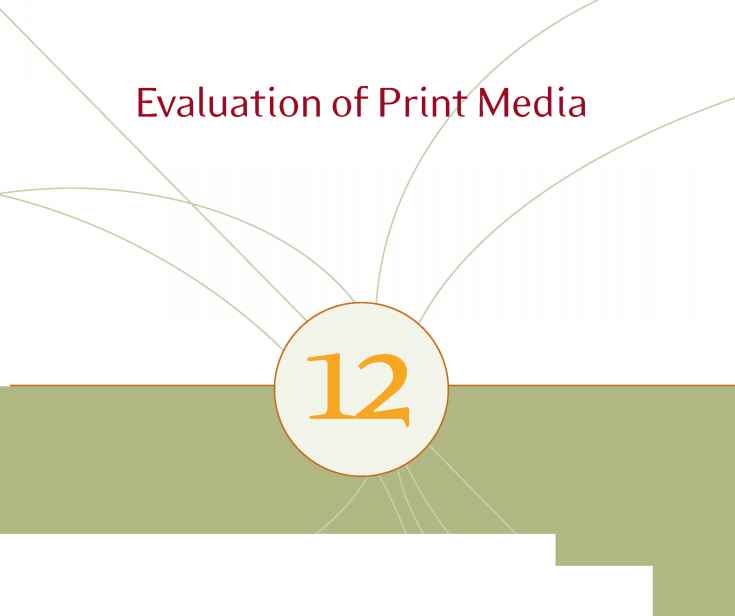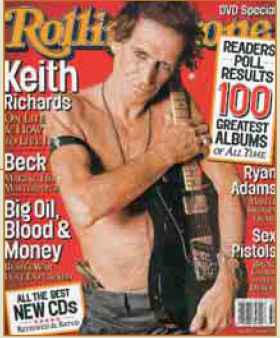Discussion Questions Cbl

- Chapter Objectives
1. To examine the structure of the magazine and newspaper industries and the role of each medium in the advertising program.
2. To analyze the advantages and limitations of magazines and newspapers as advertising media.
3. To examine the various types of magazines and newspapers and the value of each as an advertising medium.
To discuss how advertising space is purchased in magazines and newspapers, how readership is measured, and how rates are determined.
To consider future developments in magazines and newspapers and how these trends will influence their use as advertising media.
Belch: Advertising and I V. Developing the I 12. Evaluation of Print I I © The McGraw-Hill
Promotion, Sixth Edition Integrated Marketing Media Companies, 2003
Communications Program
Rolling Stone Reinvents Itself
For more than three decades Rolling Stone magazine has been considered the bible of music and popular culture. The magazine's founder and

publisher, Jan Wenner, was able to build Rolling Stone into a publishing empire because he was one of the first magazine moguls to recognize that rock 'n' roll was the language of choice for the baby-boom generation. Wenner also had the insight and daring to move the magazine beyond music into movies, politics, and other significant cultural issues. Rolling Stone took its readers to the bloody streets outside the 1968 Democratic convention in Chicago, to Woodstock, and to the Vietnam war. It also led its readers into the minds of some of the greatest performing artists of the time, such as John Lennon, Bob Dylan, and Mick Jagger, with long, penetrating interviews by Wenner himself. The magazine attracted some of the finest writers in the country and featured the work of gifted photographers such as Annie Leibovitz. It was an honor for writers to be published in the magazine and for musicians to be on the cover.
Rolling Stone dominated the music/pop cultural space for more than two decades. However, in the late 80s and early 90s the music scene began to change with the emergence of new genres such as alternative rock, metal, rap, and hip-hop. Critics note that Rolling Stone's music focus began to blur and it fell behind in its coverage of new artists and musical trends, a situation that created an opportunity for new publications. One of the major competitors to emerge was Spin magazine, which was started in 1986 by Bob Guccione, Jr., who moved the magazine aggressively into alternative rock and metal in the early 90s. Guccione notes that he modeled the magazine after Rolling Stone: "My model for Spin was Rolling Stone of the 70s, which meant something to me when I was a young man. My romanticism was to parallel what Rolling Stone meant to me when I was 18 and have Spin be that to today's people who are 18." In addition to Spin, Rolling Stone is now being encroached upon by other direct competitors such as Vibe, Blender, and Alternative Press as well as publications targeting the young male audience, ranging from ESPN The Magazine to "lad mags" such as Maxim, Stuff, and FHM.
Rolling Stone must find a way to make the magazine essential again in a publishing world that has been inspired by it and has long been chipping away at its relevance. Jan Wenner says: "Maybe there is a generational change. Maybe there is a larger significance. But Rolling Stone has got to be as relevant today as it was 25 or 30 years ago." Rolling Stone is taking steps not only to remain relevant but to recapture its position as a cutting-edge publication that is the bible of music and popular culture. The magazine has undergone a major redesign and changes to update its image and make it appealing to a younger audience. The new Rolling Stone has shorter articles, brighter colors, and less serious news content. The Rock 'n' Roll section has been expanded, with new subsections like "rock feuds," which highlights rock-star whining in convenient sound-byte form. The Reviews section has been broadened to regularly feature movies, books, DVDs, video games, and music gadgets. The New Releases section has been expanded to include more CD reviews in each issue and compete with Blender's exhaustive review section. The redesigned Rolling Stone uses more sidebars and navigational aids like toolbars that emblazon department titles across the pages it runs.
The CEO of another publishing company equates the challenge facing Rolling Stone with that facing Levi's jeans, noting: "They are both iconic brands in their own sectors, but the biggest challenge is to make sure folks don't perceive Levi's as my father's jeans and Rolling Stone as my father's magazine." In the late 80s Rolling Stone ran its now famous "Perception/reality" campaign, which was successful in repositioning the publication and changing advertisers' image of the type of person who reads the magazine. The goal of the campaign was to convince advertisers that Rolling Stone was not a "hippie magazine" read only by those stuck in the 60s but rather that it reached a well-educated and affluent audience and reflected the changing attitudes, ideas, and lifestyles of people who were changing the world. The challenge facing Rolling Stone this time is different, as it must now convince a new generation of young people that it is still relevant to them.
Sources: "It's Over 30; Can Rolling Stone Be Trusted?" Los Angeles Times, Sept. 7, 2002, pp. F1, 5; Jon Fine, Rolling Stone Reinvents Itself," Advertising Age, Aug. 26, 2002, pp. 1, 19.
Magazines and newspapers have been advertising media for more than two centuries; for many years, they were the only major media available to advertisers. With the growth of the broadcast media, particularly television, reading habits declined. More consumers turned to TV viewing not only as their primary source of entertainment but also for news and information. But despite the competition from the broadcast media, newspapers and magazines have remained important media vehicles to both consumers and advertisers.
Thousands of magazines are published in the United States and throughout the world. They appeal to nearly every specific consumer interest and lifestyle, as well as to thousands of businesses and occupations. By becoming a highly specialized medium that reaches specific target audiences, the magazine industry has prospered. Newspapers are still the primary advertising medium in terms of both ad revenue and number of advertisers. Newspapers are particularly important as a local advertising medium for hundreds of thousands of retail businesses and are often used by large national advertisers as well.
Magazines and newspapers are an important part of our lives. For many consumers, newspapers are their primary source of product information. They would not think of going shopping without checking to see who is having a sale or clipping coupons from the weekly food section or Sunday inserts. Many people read a number of different magazines each week or month to become better informed or simply entertained. Individuals employed in various occupations rely on business magazines to keep them current about trends and developments in their industries as well as in business in general.
While most of us are very involved with the print media, it is important to keep in mind that few newspapers or magazines could survive without the support of advertising revenue. Consumer magazines generate an average of 47 percent of their revenues from advertising; business publications receive nearly 73 percent. Newspapers generate 70 percent of their total revenue from advertising. In many cities, the number of 392 daily newspapers has declined because they could not attract enough advertising rev-
enue to support their operations. The print media must be able to attract large numbers of readers or a very specialized audience to be of interest to advertisers.
The role of magazines and newspapers in the advertiser's media plan differs from that of the broadcast media because they allow the presentation of detailed information that can be processed at the reader's own pace. The print media are not intrusive like radio and TV, and they generally require some effort on the part of the reader for the advertising message to have an impact. For this reason, newspapers and magazines are often referred to as high-involvement media.1 Over 80 percent of U.S. households subscribe to or purchase magazines, while the average household buys six different magazines each year.2
Newspapers are received in nearly two-thirds of American households daily. Most magazines, however, reach a very selective audience. Like radio, they can be valuable in reaching specific types of consumers and market segments. While both magazines and newspapers are print media, the advantages and disadvantages of the two are quite different, as are the types of advertising each attracts. This chapter focuses on these two major forms of print media. It examines the specific advantages and limitations of each, along with factors that are important in determining when and how to use newspapers and magazines in the media plan.
Over the past several decades, magazines have grown rapidly to serve the educational, informational, and entertainment needs of a wide range of readers in both the consumer and business markets. Magazines are the most specialized of all advertising media. While some magazines—such as Reader's Digest, Time, and TV Guide—are general mass-appeal publications, most are targeted to a very specific audience. There is a magazine designed to appeal to nearly every type of consumer in terms of demographics, lifestyle, activities, interests, or fascination. Numerous magazines are targeted toward specific businesses and industries as well as toward individuals engaged in various professions (Exhibit 12-1).
The wide variety makes magazines an appealing medium to a vast number of advertisers. Although TV accounts for the largest dollar amount of advertising expenditures among national advertisers, more companies advertise in magazines than in any other medium. Users of magazines range from large consumer-product companies such as Procter & Gamble and General Motors, which spend over $400 million a year on magazine advertising, to a small company advertising scuba equipment in Skin Diver magazine.
Continue reading here: Classifications of Magazines
Was this article helpful?